Table of contents
- PS helmet test: upper-class racing helmets Top sports helmets in a comparison test
- AGV GP-Tech
- Arai RX-7 GP
- BMW Sport
- Marushin 999 RS
- Schuberth S1 Pro
- Shark RSR2
- Shoei X-Spirit II
- Uvex Onyx Carbon
- Test winner: X-Lite X-802
- CONCLUSION
- Shock absorption in detail
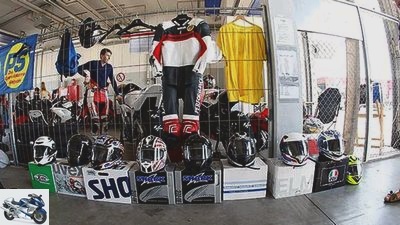
Jahn
clothing
Helmets
Helmet test upper class racing helmets
PS helmet test: upper-class racing helmets
Top sports helmets in a comparison test
Content of
Well-known providers can pay dearly for their top sports helmets at well over 500 euros. Is this investment worth it? Nine racing helmets put to the test.
Sebastian Lang
01/26/2011
High-priced sports helmets are now a fairly extensive market. In the past two years alone, AGV, Shoei and Arai three manufacturers’ top models over the 500 euro mark on the market. Are these noble shells worth the money, or should amateur racers better invest their money in a cheaper helmet? Eventually the rest of the budget could be used to buy a pair of boots, a racing fairing, or a new set of tires.
PS wanted to know and invited all manufacturers to send their best racing helmet into the race. BMW, Marushin, Schuberth, Shark, Uvex and X-Lite participated. HJC canceled due to the large price range of the test field from 239 euros (Marushin) to 769 euros (Arai).
In order to meet all requirements, PS split the test procedure into three parts, which were finally brought together to one result: In the first part, two GSX-R-750 pilots tested the helmets for two days on the racetrack, in the second part they were on a Kawasaki Z 1000 determined the quality of the country roads. The test pilots rated each helmet in the categories of fit / comfort, aerodynamics, acoustics, ventilation, field of vision, weight and handling. At the same time, in the third part, TuV Rheinland tested another model of each test candidate for its shock absorption values.
FIT
The fit and comfort of a helmet play a decisive role, especially when it comes to long, intense loads such as on the racetrack. Pressure points or too loose a seat interfere with concentration. The weighting of this category in the overall score is correspondingly high.
The models by Arai and Shoei fit perfectly straight away. Thanks to the soft inner lining, the two Japanese do not become uncomfortable even on long journeys and, thanks to the full seat, they are also perfect for fast laps on the racetrack. The X-Lite also fits perfectly, but its inner lining feels slightly scratchy after a while. The inner lining of the AGV feels scratchy immediately after putting it on. In addition, the Italian helmet is clearly too tight and is already pressing extremely on the forehead after a few laps. Marushins 999 RS sits a little better overall, here the scratchy inner lining and the somewhat uncomfortable shape in the ear area are more of a problem. The Schuberth is a special case: Actually a very comfortable helmet with a wonderfully soft inner lining, it is too big in size M and therefore only touches the pilot’s head at certain points.

jkuenstle.de
Helmet test on the racetrack.
AERODYNAMICS
Interestingly, the helmet weight does not allow any conclusions to be drawn about the aerodynamics. The heaviest helmet, the RX-7 GP, is best placed in the airstream. X-Lites X-802 also leaves a very good impression and feels very light and compact while driving. The same applies to Shoei’s model. In addition to the buoyancy, the effort required to turn the head is also included in the aerodynamics rating, a property that is particularly common in the rather bulky helmets of Schuberth and BMW have some problems and lose important points. By far the lightest helmet from Marushin Can also not fully convince aerodynamically and ends up just ahead of the heavy Schuberth.
ACOUSTICS
In contrast to helmets that are designed for country roads, the interior noise in racing helmets plays a subordinate role because of the additional earplugs used, which is why only a maximum of five points were awarded for it in the overall horsepower rating. Schuberth and BMW are unimpressed acoustically in top form and he-
pass full marks, while the X-Lite model screams for earplugs on the country road.
VENTILATION
In addition to the pure cooling performance, the operation of the buttons and sliders also plays a role in this category – a topic with which almost all test candidates have problems. Only BMW, Schuberth and Arai allow intuitive operation thanks to large flaps (Schuberth and BMW) or easy-to-touch buttons (Arai). The Shark system serves as a negative example: The control buttons are tiny, work on the chin, forehead and back of the head according to a different principle and make targeted adjustment while driving almost impossible.
The cooling performance of the test candidates also differs greatly: while Schuberth and BMW literally let their hair blow under their helmets, Marushin’s head ventilation is hardly noticeable. AGV, Shoei and X-Lite achieve good cooling performance, but do not quite reach the level of the two German helmets from Schuberth and BMW. Arai and Uvex leave an ambivalent impression. The face ventilation works flawlessly on both helmets, but the head ventilation should be a bit stronger at high temperatures.
FIELD OF VIEW
The field of vision plays an important role on the racetrack. Annoying when, as in the case of the AGV, the edge of the helmet and red lettering on the inner lining disturb the view ahead. The rest of the test field shows how it can be done better and shines with a large field of vision. There are only deductions for the factory-attached Pinlock visors at Schuberth and BMW, which are annoying when the head is lowered. Pleasing: All test helmets remained completely fog-free during the sweaty racetrack test.
HANDLING
In addition to pure performance, there are a few other properties that make a good helmet: suitability for glasses, double-D lock, visor operation. The test models from Arai, Shoei and Uvex are convincing in all three properties. The X-802 is also pleasing, but the slightly deep visor edge is annoying in everyday use when it is open. Larger prints are available for the AGV, BMW and Marushin models. The reason for this is the extremely fiddly double-D lock in all three candidates. Loosening the chin strap in particular turns out to be a real game of patience. Good news, on the other hand, for all those who wear glasses: apart from slight restrictions with AGV, Shark and Marushin, threading the temples in all models was problem-free.
In terms of equipment, the test candidates are quite similar, with the exception of the S1 Pro. The Schuberth is the only model to have a sun visor – an extra that is superfluous for the racetrack and which also weighs on the weight.
AGV GP-Tech
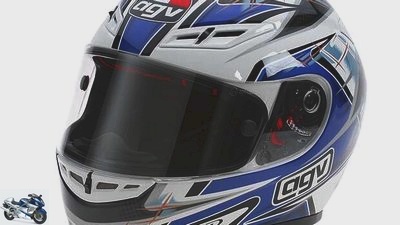
MPS photo studio
AGV GP-Tech: The inner lining is a real eye-catcher – in the top step, the chin ventilation pushes the visor up slightly.
CONCLUSION
The AGV GP-Tech produced in Italy is well made, but otherwise not convincing. The field of vision is too small, especially upwards, and the helmet is very tight and the lining is scratchy. At 1530 grams, the GP Tech is one of the heavier test models, which is also noticeable in the aerodynamics of the helmet. The well-functioning ventilation should be positively emphasized: Operation and air flow are pleasing both on the country road and on the racetrack.
Score: 55
Contact: Haberlein & Mauerer AG,
80801 Munich,
Tel. 089/3 81 08-104,
www.agv.it
price: from 589.00 euros
Weight: 1530 g
Sizes: XS-XXL
Arai RX-7 GP
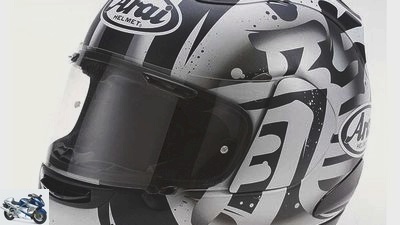
MPS photo studio
Typical Arai: the visor lock. On the other hand, the adjustable spoiler on the back of the head is atypical.
CONCLUSION
Arai didn’t manage to provide helmets for the impact test by the end of the helmet test, which is why the RX-7 GP is out of competition. Otherwise, the fit and comfort of the expensive and heavy helmet are particularly popular. The field of vision is slightly restricted by the forehead ventilation. The ventilation is not quite at the top level, but it is easy to use. Despite the high weight, the Arai has the best aerodynamics in the test. The processing is great.
Score: Not applicable
Contact: Arai Helmet Germany,
46519 Alps,
Tel. 0 28 02/9 48 48-0,
www.araideutschland.de
price: from 769.00 euros
Weight: 1580 g
Sizes: XS-XXL
BMW Sport

MPS photo studio
Bad solution: the push button for the chin strap can only be found with a lot of fiddling. Well solved: The large mechanism on the chin ventilation.
CONCLUSION
Perhaps the biggest surprise of the helmet test: BMW Sport came in second. The Bavarian model impresses with the typical Schuberth values: good ventilation, whisper-quiet interior noise, comfortably soft interior lining. In addition, there is the large field of vision and the good shock absorption values. On the negative side are the mediocre aerodynamics, the very fiddly double-D lock when opening and the not quite perfect fit.
Score: 70
Contact: BMW motorcycle,
80809 Munich,
Tel. 01 80/5 00 19 72,
www.bmw-motorrad.de
price: from 425.00 euros
Weight: 1310 g
Sizes: 52 / 53-62 / 63
Marushin 999 RS

MPS photo studio
Lightweight: at 1160 grams, the 999 RS is only 10 g above the factory specification. The operation of the chin ventilation was quite fiddly.
CONCLUSION
Even if the overall result doesn’t look like it: the 999 RS has a lot of potential. Its unique Stonefibre material is light as a feather and delivers the best values in the TuV shock absorption test. Perhaps Marushin should sell the helmet, which is unrivaled at 239 euros, a little more expensive and instead install a smoother, more evenly fitting inner lining, a better-functioning double D-lock and more effective ventilation.
Score: 64
Contact: JF-Motorsport GmbH,
61239 Obermorlen,
Tel. 0 60 02/91 03-0,
www.jfmotorsport.de
price: from 239.00 euros
Weight: 1160 g
Sizes: XS-XXL
Schuberth S1 Pro

MPS photo studio
As usual, the ventilation of the Schuberth is exemplary. The sun visor, which is atypical for a racing helmet, puts pressure on the weight.
CONCLUSION
Very similar to the test model from BMW in many areas, the S1 Pro from Schuberth loses decisive points, especially when it comes to aerodynamics. In contrast to the BMW Sport, the helmet is too big and with its soft inner lining only touches the head at certain points. In addition, the unnecessary sun visor on a racing helmet spoils the weight rating. Otherwise there is nothing to complain about: ventilation and comfort are great, as is the volume. Try on before buying!
Score: 66
Contact: Schuberth GmbH,
39126 Magdeburg,
Tel. 03 91/81 06-0,
www.schuberth.de
price: from 499.99 euros
Weight: 1520 g
Sizes: XS-XXL
Shark RSR2
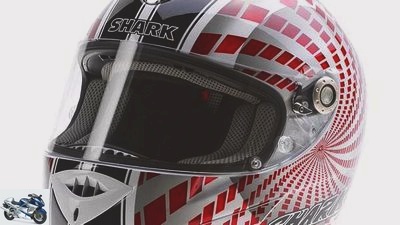
MPS photo studio
Shark RSR2: The visor change mechanism at the push of a button works intuitively.
CONCLUSION
Shark offers the RSR2 in two versions: as a full carbon helmet for 589.95 euros and with fiberglass for 110 euros less. Apart from the different chin strap attachment, the two models do not differ in the test. The inner lining is comfortable and the field of vision is very large. In terms of shock absorption and ventilation mechanics, Shark should urgently make improvements. The Shark does not offer enough space in the chin and nose area.
Score: 61
Contact: Shark helmets Germany,
21224 rose garden,
Tel. 04108/458003,
www.shark-helmets.com
price: from 479.95 euros
Weight: 1450 g
Sizes
: XS-XXL
Shoei X-Spirit II
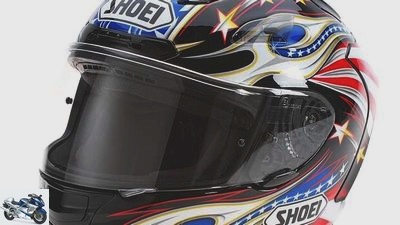
MPS photo studio
The visor lock is located below the mechanism. The emergency system on the inner lining makes it easier to remove the helmet after a fall.
CONCLUSION
The poor shock absorption values cost the X-Spirit II the test victory. Otherwise, the Shoei is convincing across the board: the helmet fits perfectly and feels very compact, the field of vision is huge. The ventilation is also okay, but it should be a bit stronger on the head. A special feature of the Shoei is the emergency system, which is intended to enable rescuers to remove the inner padding after a fall, so that the pilot can take off the helmet more easily.
Score: 69
Contact: Shoei GmbH,
40595 Dusseldorf,
Tel. 02 11/17 54 36-0
www.shoei.de
price: from 669.00 euros
Weight: 1470 g
Sizes: XS-XXL
Uvex Onyx Carbon
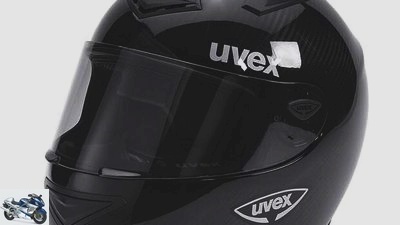
MPS photo studio
The carbon fiber mats of the Uvex Onyx Carbon are very carefully processed, the chin ventilation flap, on the other hand, looks a bit cheap.
CONCLUSION
The most noticeable thing about Uvex Onyx Carbon is its technically very well laminated outer shell. Otherwise, smaller strengths and weaknesses push the Uvex into midfield. The inner lining is extremely fluffy and soft, but it presses a little on the ears and feels doughy when put on and taken off. The ventilation works well below, only moderately above. The smooth double D-lock and the large field of view as well as the good aerodynamics are positive to mention.
Score: 66
Contact: Uvex GmbH & Co. KG,
90766 Fuerth,
Tel. 09 11/97 74-0,
www.uvex-sports.de
price: from 599.95 euros
Weight: 1230 g
Sizes: XS-XXL
Test winner: X-Lite X-802

MPS photo studio
Like the Shoei model, the X-Lite also has a visor lock on the left. The spoiler is wider than that of the Arai and adjustable.
CONCLUSION
Not perfect in all areas, but the bottom line is the best: the X-Lite X-802. The Italian helmet convinces with a very good fit, well-functioning ventilation, great aerodynamics and a large field of vision. When open, the deep visor edge is a bit annoying in city traffic, and the inner lining is likely to be a bit softer. The shock absorption values are good and ultimately give the X-Lite the decisive advantage over Shoei’s X-Spirit II.
Score: 71
Contact: Nolangroup Germany GmbH,
71272 Renningen,
Tel. 0 71 59/9 31 60,
www.nolangroup.de
price: from 419.50 euros
Weight: 1310 g
Sizes: XS-XXL
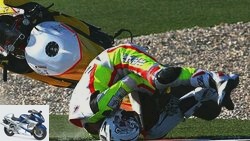
Helmets
Comparison test sports helmets
Sporty helmets up to 400 euros
read more
CONCLUSION
CONCLUSION
The most expensive model is not always the best. The price of the test winner X-Lite X-802 is just as much in the midfield as that of the second-placed BMW Sport, whereas the AGV GP-Tech, a significantly more expensive model, reaps the red lantern. The result of the crash test is also surprising: The inexpensive and light Marushin 999 RS delivers the best shock absorption values, Shoei’s noble X-Spirit II shell lands at the bottom.
Shock absorption in detail
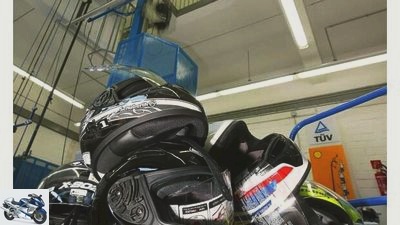
jkuenstle.de
The test field was badly battered after the crash tests.
The development of norms is often the same as in politics: several parties argue back and forth for a long time and in the end agree on the lowest common denominator that can be implemented in practice. The current – and already slightly outdated – motorcycle helmet standard ECE-R 22.05 is no exception: The specified maximum values are well above what a human head could withstand undamaged, the test points at which the motorcycle helmet is tested have the real ones Little to do at impact points.
On the basis of these facts, the PS sister magazine MOTORRAD developed its own shock absorption test procedure in cooperation with experts in the spring of 2010, which better corresponds to the conditions of a motorcycle fall. The helmets are tested at normal room temperature instead of at minus 20 degrees, which are technically demanding, instead of the standard test points, the helmets fall flat on their side (side flap).
Other differences concern the surcharge itself. In addition to the impact speed of 7.5 m / s prescribed by the ECE standard, the MOTORRAD test procedure also provides for a test at 5.5 m / s. The reason for this is the damping material, which in some cases only begins to work from a certain load and so could possibly lead to more serious injuries at slower speeds. Instead of the flat standard anvil, the impact surface is a Sigma post, as can be found on several German country roads as a guardrail holder.
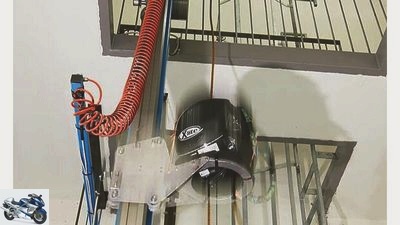
jkuenstle.de
In the chin strike test, the helmets fall 7.5 m / s onto an edge anvil.
In addition to the side chop, the helmets must hit the chin at 7.5 m / s on an edge anvil. Since some of the forces that arise are passed on to the chinstrap and are therefore not recorded by the TuV test bench, the indication of the g-forces on the chin only serves to complete the process and is not included in the shock absorption assessment.
PS sent the test candidates for the shock absorption test to TuV Rheinland, where they were tested for their abilities under the expert hands of Sven Schneider. Unfortunately, Arai could not deliver any models for the impact test until the end of the test and is therefore out of the evaluation. All helmets remained below the limit of 275 g set by the ECE standard, and the maximum HIC value (Head Injury Criterion, a measure that indicates the expected severity of the head injury) of 2400 was not exceeded by any of the test candidates. The results of the brightest and lightest test candidate, Marushin 999 RS, were encouraging. The helmet achieved the lowest values in all four categories assessed. The BMW Sport also did well, narrowly missing the Marushin’s top scores. On the other hand, the shock absorption test was disappointing for Shoei: The highest HIC values for the right and left side impact and very high g-forces push the X-Spirit II all the way back.
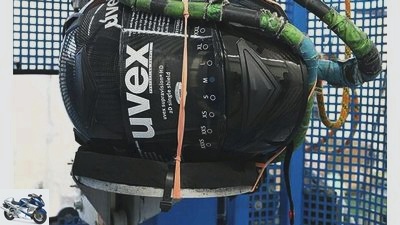
jkuenstle.de
Realistic fall on the Sigma post: The Uvex when it hits the side.
To evaluate the crash test results, the HIC values (analogous to the
g-values) of the lateral runout added right and left and then scored on the basis of the following grid: 2000-2200: 10 points; 2201-2400: 9 points; …; 2801-3000: 6 points (similarly for the g-values: 280-300: 10 points; 301-320: 9 points; …; 381-400: 5 points). The points for the HIC and g values were then added up, so that a maximum total of 20 points results – which the Marushin was the only one to achieve.
The optical damage turned out to be very different regardless of the test results. While one or the other ventilation flap broke or flew away when you hit your chin, the side blows on the X-Spirit II left no visible traces apart from minor scratches. So here’s the advice: After a fall on the head, the helmet must be replaced, no matter how good it looks from the outside. The damping material is compressed on impact and can no longer offer adequate protection in the event of a further fall.
Related articles
-
Motorcycle helmets for sports riders in the test
2Snap clothing Helmets Motorcycle helmets for sports riders in the test Product test: racing helmets Motorcycle helmets for sports riders in the test…
-
Flip-up motorcycle helmets in the test
Horny clothing Helmets Flip-up motorcycle helmets in the test Product test flip-up helmets Motorcycle helmets that can be opened up in comparison What…
-
Product test: top-class sports helmets in comparison
2snap clothing Helmets Product test: top-class sports helmets in comparison Comparative test sports helmets of the upper class Well protected with the…
-
Comparison test sports helmets
Jahn clothing Helmets Comparison test sports helmets Comparison test sports helmets Sporty helmets up to 400 euros Content of How much helmet do you get…
-
Comparison test flip-up helmets
Bilski clothing Helmets Comparison test flip-up helmets Comparison test flip-up helmets Open air performance The popularity of flip-up helmets is…
-
Product test full-face helmets with integrated sun visor
mps photo studio clothing Helmets Product test full-face helmets with integrated sun visor Product test full-face helmets with integrated sun visor…
-
Motorcycle helmets: test, purchase advice, ECE standard, communication
Herder 14th pictures Herder 1/14 Jorg Lohse trying in vain to mount a wind deflector on the X-lite. Can you test harder? no! Herder 2/14 The Schuberth S1…
-
Motorcycle helmets made of carbon in the test
Hertneck clothing Helmets Motorcycle helmets made of carbon in the test test Carbon helmets Without coal there is no carbon – this is true at least for…
-
Product test: Seven enduro helmets in the test
MPS photo studio clothing Helmets Product test: Seven enduro helmets in the test Product test: Enduro touring helmets Seven enduro helmets in a…
-
Artist clothing Helmets Test new full face helmets Test new full face helmets Fresh goods Now they are back on the shelves: the new full-face helmets for…